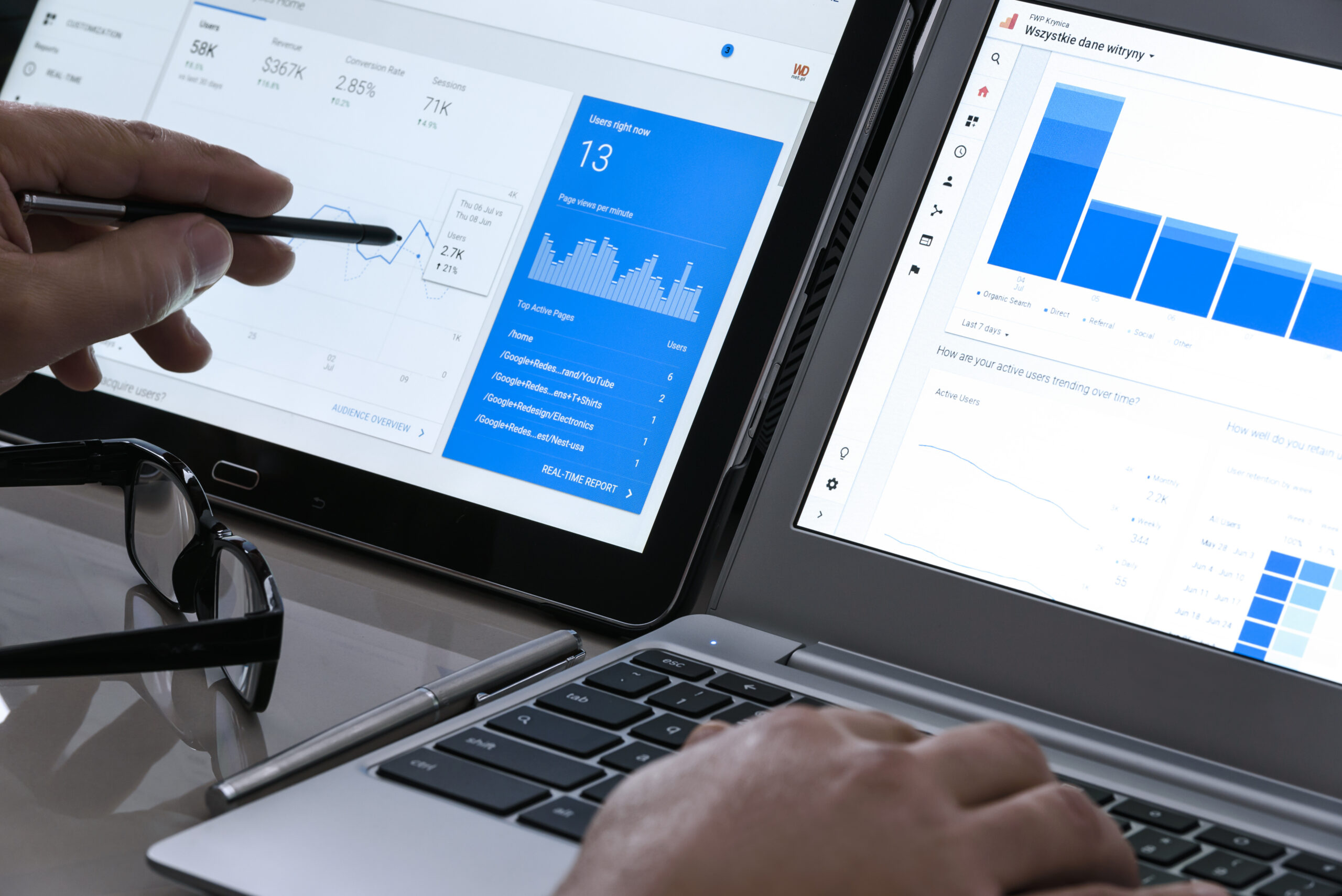The conversion rate is the percentage of users amongst website visitors who complete a desired action on the site, like making a purchase, signing up for a service, contacting your team for more information, or any other goal you’ve set for them. Your conversion rate indicates how effectively this website traffic is converted to customers.
In an analysis run by Wordstream, the median conversion rate across a range of accounts was 2.35%. This means that for every 100 visitors, two will complete the desired action you set for them.
The challenge is clear: how do you bring in more visitors to increase your chances of turning those clicks into meaningful interactions? This blog has the answers.
We’ll provide you with practical strategies to maximize your website’s traffic, ultimately boosting those conversion rates. Because higher conversion rates translate to better sales.
How Can Website Traffic Improve Conversion Rate?
Maximizing website traffic and improving the conversion rate are closely related metrics.
Theoretically, more traffic means more conversions. In reality, this isn’t the case because not all traffic is relevant. But if you attract your ideal customer to your website, more such qualified traffic can translate to higher conversion rates. As you implement strategies to attract more targeted visitors to your site, the potential for conversions increases.
As your conversion rate improves, it signals search engines that your website offers value-based content for users. In turn, search engines push the website up the search engine pages.
How To Maximize Website Traffic?
The below sections present potent approaches that when combined can direct your target audience to your website and maximize the chances of improving your conversion rate.
Optimizing Your Website for Search Engine
Search Engine Optimization (SEO) involves enhancing your website to make it valuable, credible, and user-friendly. SEO-optimized websites often rank higher in search results, increasing visibility to the target audience. The optimization process includes a combination of strategies.
Optimizing On-Page Factors
On-page factors encompass elements like titles, meta descriptions, headers, URLs, internal links, and anchor text. Optimizing these factors aligns your website content with relevant search queries, helping search engines discover and index your site. This makes your site more accessible to users searching for related information.
Here’s the breakdown to optimize on-page factors:
- Craft Concise, Keyword-Rich Titles: These are your digital headlines. Well-worded titles capture user attention easily and set the stage for the webpage content.
- Word Your Meta Descriptions Thoughtfully: Summarize web page content and entice users to click.
- Use Headers Strategically: Make your content more readable and scannable. When you use headers correctly, you make the reading experience smoother.
- Simplify Your URL: Create a URL that is readable, and relevant to your page’s content for better search engine understanding.
- Master Internal Linking: Strategically place internal links so that you create an efficient roadmap for users and search engines to explore related content. Effective internal linking enhances user navigation and encourages longer visits.
- Optimize Anchor Text: Choose descriptive and relevant anchor text to guide users and search engines to the linked pages. Instead of generic phrases like “click here,” use anchor text that gives users and search engines a clear idea of what to expect on the linked page.
- Place Links Contextually: Insert internal links naturally within your content. Ensure they complement the current topic.
- Diversify Internal Links: Distribute links across various pages. Avoid overwhelming a single page.
- Regularly Update Links: Revisit and update internal links as your content evolves.
Crafting Keyword-Rich Content

When you plug in keyword-rich content in your website, you make your website align with user search queries. Search engines consider your website to be of value and therefore tend to make it more accessible to users.
Here’s your guide:
- Anticipate User Questions: Bring value to your content by addressing potential user questions and aligning content with common search queries.
- Utilize Keyword Tools: Use tools like Google Keyword Planner, SEMrush, or Ahrefs to identify impactful keywords in your niche.
- Understand User Intent: Understand the intent behind keywords to customize your content to users’ needs. Figure out if your users are seeking information, looking to make a purchase, or exploring a specific topic.
- Avoid Awkward Keyword Placement: Ensure keywords naturally fit within your content.
- Strategic Placement of Keywords: Place keywords in critical areas like titles, headers, and opening and closing paragraphs.
- Embrace Variations: Use variations and synonyms of keywords to enrich your content. Aim for a balance between SEO optimization and genuine value to readers.
Guest Blogging on High Authority Websites
When you contribute valuable content to high-authority websites, you tap into their established audience and insert links that drive the new audience to your website. In this way, you not only end up getting new traffic but also position your website as credible and authoritative in your niche. You automatically improve your website’s visibility.
Follow these tips when you decide to guest blog.
- Identify Reputable Platforms: Choose high-authority websites and blogs that align with your industry or niche. These could be influencers, industry publications, or well-respected blogs.
- Craft Valuable Content: Write insightful content showcasing your expertise and addressing the pain points or challenges your audience faces.
- Naturally Include Relevant Links: Include links back to your website within the content. Building quality backlinks is like earning referrals from reputable sources. It speaks about the relevance of the connections you create.
- Ensure Link Relevance: Ensure that the linked content on your website is relevant to the guest post.
Getting Featured in Industry Directories
When your business is listed in reputable industry-specific directories, it enhances visibility among potential customers who are actively searching for products or services in your niche. This exposure increases the likelihood of attracting targeted and relevant traffic to your website. Additionally, industry directories act as a credible endorsement for your website.
Follow these guidelines for featuring your business in industry directories.
- Choose Reputed Directories: Look for industry-specific directories that cater to your niche.
- Optimize Business Information: Ensure your business information is complete, accurate, and optimized for search.
- Craft Compelling Descriptions: Create engaging descriptions of your products or services. Highlight what makes your business unique and valuable.
- Encourage Reviews: Politely encourage satisfied customers to leave reviews on your directory profiles.
Enhancing User Experience and Website Performance
A user-friendly website with faster loading times and mobile-responsive designs encourages visitors to stay longer, explore more pages, and engage with the content. Search engines favor such websites, improving search rankings and website visibility, paving the way for more website traffic.
This is your how-to guide to improving your website’s user experience.
- Prioritize Website Speed: Compress and optimize images, use essential plugins, and enable browser caching for faster website speed.
- Embrace Mobile-Responsive Design: Implement responsive design principles for a seamless user experience on various devices.
- Simplify Navigation: Ensure easy navigation on smaller screens, making it convenient for users to explore your website.
Creating Compelling and Shareable Content
In the present age of information overload, ordinary content falls by the wayside. To stand out, your content must be engaging, informative, and resonate with your audience. This will prompt readers to share it across social media platforms, expanding its reach. Shared content acts as a referral. It brings in new visitors to your website.
Follow these best practices to make your content share-worthy.
- Prioritize Value Over Volume: Focus on delivering content that adds genuine value rather than churning out sheer volume.
- Research In Depth: It’s this depth that distinguishes your material and establishes credibility.
- Use Conversational and Informative Tone: Aim to connect with readers on a personal level.
- Have a Logical Structure: Insert clear headings and subheadings. This logical flow enhances readability and understanding.
- Make Content Visually Appealing Elements: Infographics and charts are excellent tools for simplifying complex information.
- Insert Engaging Videos: Integrate engaging and informative videos whenever possible. Videos make your content dynamic and capture and retain audience interest.
- Make Video Introduction Captivating: An attention-grabbing introduction sets the tone and immediately grabs the viewer’s attention.
- Keep Your Video Messaging Clear and Concise: Clarity ensures that your audience grasps and retains the information presented.
- Optimize Video Titles and Descriptions: This practice makes your website get discovered easily.
- Use Eye-catching Thumbnails: Use attention-grabbing thumbnails that accurately represent your video content and make it intriguing for users.
- Provide Transcripts: Offering transcripts for your videos enhances clarity and accessibility for all types of users. Transcripts also contribute to improved search engine indexing.
Using Email Marketing
Email marketing aims to entice users to visit your website through strategically placed links, calls to action, and engaging content within the emails. It encourages users to click on these links. Explore the potential of email marketing to drive website traffic by following these tips.
- Tap Into the Power of Lead Magnets: For the uninitiated, a lead magnet is an incentive or valuable offering that businesses provide to potential customers in exchange for their contact information, typically their email address, to build and nurture a relationship. Consider various lead magnet options, like ebooks, whitepapers, webinars, or exclusive discounts. Provide valuable content that resonates with your audience’s interests via lead magnets.
- Strategically Place Lead Magnets: Place lead magnets strategically on your website. Ensure they are prominently visible and seamlessly integrated with your content.
- Craft Compelling Pop-Ups and Opt-In Forms: Utilize pop-ups and opt-in forms judiciously. Craft compelling copy and convey to your audience the value of subscribing to your website.
- Incentivize Sign-Ups: Consider offering incentives, like exclusive content or limited-time discounts, to encourage sign-ups.
- Ensure a Mobile-Responsive Design: With the prevalence of mobile users, it becomes critical to maintain a seamless experience across devices.
- Enhance Personalization through Segmentation: Provide segmentation options in your forms. Allow users to choose the type of content they wish to receive. This enhances personalization and builds greater engagement.
Considering Paid Advertising Strategies
Paid advertising strategies, like Google Ads and social media ads, involve creating and placing advertisements to reach the target audience. These platforms offer advanced targeting options, allowing advertisers to define their audience based on demographics, interests, behavior, and other criteria. This precision ensures that the ads are shown to individuals who are more likely to be interested in the products or services being promoted. When users click on these ads, they are directed to your website’s landing page.
Follow these best practices.
- Use Google Ads for Targeted Traffic: Craft compelling ad copy, choose relevant keywords, and employ targeted bidding strategies to reach your audience effectively.
- Tap Into Social Media Ads for Engaging Demographics: Engage users with visually appealing creatives and compelling calls to action.
- Optimize Ad Campaigns for Performance: Identify high-performing ads and understand audience behavior. This data-driven approach enhances the efficiency of your advertising efforts.
- Implement A/B Testing to Fine-tune Your Ad Elements: Experiment with different headlines, visuals, and calls to action to discover what resonates most effectively with your target audience.
- Align Landing Pages With Ads: A cohesive user journey, from ad click to landing page, enhances user experience and encourages conversions.
- Customize Ad Scheduling: Understand the peak activity times of your target audience. Maximize your campaign’s visibility to optimize your advertising impact.
- Enhance Quality Score Enhancement: Focus on improving your Quality Score in Google Ads. A higher Quality Score reduces costs and boosts ad visibility.
Implementing Social Media Strategies

Social media platforms are an extension of the website content. When users find your content interesting or valuable and engage with you, they are more likely to visit your website for additional information or to make a purchase. Furthermore, if your content is shareable and resonates with users, they may share it within their networks. This organic sharing can significantly expand your reach and bring in new visitors to your website.
Here’s some quick advice on exploring social media strategies to drive website traffic.
- Share Valuable Content: Share content that adds value to your audience’s lives. Whether it’s informative articles, tutorials, or tips, providing valuable information encourages sharing.
- Increase Your Content’s Discoverability: Craft attention-grabbing captions, use relevant hashtags, try storytelling, and use high-quality visuals.
- Actively Engage Your Audience: Respond thoughtfully to comments, and messages, and participate in discussions. Aim to create a connection that motivates followers to explore your website.
- Encourage User Participation: Plug in contests and giveaways. These activities boost engagement and prompt users to share your content, extending your website’s reach.
Localizing the Website
46% of all searches on Google include local intent. 97% of users searched online to find a local business. 78% of local searches on mobile result in an offline purchase. These statistics shout out the fact that search engines often prioritize localized content for users in specific regions.
Optimizing your website for local languages and preferences can improve its visibility in regional search engine results and attract more organic traffic. Users are more likely to share content that is culturally relevant and available in their preferred language. This can lead to organic word-of-mouth promotion and drive additional traffic to your website.
Follow these guidelines to localize your website.
- Translate Website Content Into Local Languages: This practice makes content accessible to a diverse and untapped audience.
- Customize Imagery and Design Elements: Creating a visually appealing and culturally relevant interface strengthens the connection with users.
- Adapt Your Content: Tailor your content based on regional holidays, events, or specific geographic interests to stay contextually relevant.
Personalizing the Website
Elements such as customized navigation, recommended products or articles, and personalized greetings lend a personal touch to the user experience on the website. Website personalization aligns with users’ interests, preferences, and previous interactions, and makes users feel valued. It encourages them to stay longer on the website. This increases the likelihood of repeat visits. Search engines interpret this user behavior positively and boost the website’s rankings, improving its visibility. The chances of attracting new visitors and driving increased website traffic significantly rise.
Follow these guidelines.
- Use Data-Driven Recommendations: Use data insights to recommend personalized content, products, or services.
- Customize Communication: Address users individually to add a personal and exclusive touch and build a sense of being valued in the digital landscape.
How To Measure Website Traffic?

Now that we’ve explored a variety of ways to bring traffic to your site, analyzing data from the following tools will help pinpoint which marketing channels are most effective in driving users to your site.
Google Analytics
Google Analytics gives comprehensive insights into user behavior on your website. Use it to track page views, bounce rates, and user journey paths. Its features like behavior flow can help you understand how users navigate your site.
This tool helps you:
- Get a picture of the high-performing pages within your website
- Optimize the web pages that may experience high bounce rates
- Refine your website’s structure and content strategy
- Heighten user satisfaction
- Boost SEO rankings
Consider a scenario where Google Analytics reveals that your SEO efforts are driving a substantial portion of your website traffic. This insight suggests that your website is effectively optimized for search engines, attracting users organically through relevant search queries. On the flip side, the data may indicate that your social media campaigns are not generating the expected engagement or visits.
In response to this information, Unframed Digital would recommend directing more budget and manpower toward enhancing the success of SEO initiatives. This approach ensures a strategic allocation of resources based on real-time data, maximizing the impact of marketing efforts.
Microsoft Clarity
Microsoft Clarity lets you know how users interact with your website through its features: Session Recordings and Heatmaps. Use these findings to make your website user-friendly and maximize conversion rates.
Session Recordings: This feature assists you in examining user behavior on your website. They tell you which webpage works best, and where users get stuck and drop off.
Suppose Session Recordings reveal that users frequently abandon the checkout page before completing a purchase. In this scenario, adopting any or all of the below approaches can be beneficial.
- Optimize the Checkout Process: Implement a user-friendly, step-by-step approach, ensuring that customers can easily navigate through the checkout process.
- Simplify Form Fields: Consider minimizing the required information to only essential details. Implement autofill options or progress indicators to further enhance the user experience.
- Address Potential Technical Issues: Regularly monitor for slow loading times, error messages, or payment processing issues.
These targeted improvements can enhance the user experience and potentially increase conversion rates.
Heatmaps: This feature visualizes user engagement patterns. It highlights where users click the most, where they scroll, and the sections that capture their attention.
You can use this information to
- Place your call-to-action (CTA) button in a high-traffic zone within your website to increase the chances of users clicking it.
- Feature more relevant content in a highly-visited section of the webpage or replicate successful content strategies in other parts of your website.
- Streamline product information, and ensure vital details are visible without extensive scrolling.
- Simplify or reposition form fields based on user behavior, making the form-filling process smoother.
- Rearrange content to ensure essential information is presented early on the page.
HotJar
HotJar offers functionalities similar to Microsoft Clarity. Like Microsoft Clarity, this tool also provides tools like Heatmaps and Session Recordings. What makes it distinctive are the additional perks — customizable user feedback forms. These features allow you to gather direct input from users directly on your website. Moreover, HotJar can integrate with industry-leading tools, like HubSpot, Mixpanel, and Google Analytics.
These tools not only measure website traffic but eventually help you build a more user-friendly online presence and improve your conversion rate.
Synergistic Strategies To Improve Conversion Rate
This blog explains the holistic approach of combining SEO optimization, engaging content, and strategic social media tactics to maximize web traffic and enhance conversion rates.
While you follow the above tips and guidelines, remember to tailor these strategies to your industry specifics. Dive into the website content insights, assess your current metrics, and elevate your online presence with industry-centric customization.
Your journey doesn’t stop at this blog. Treat our guidelines as the starting steps to a continuous process of improvement. Regularly revisit your website analytics, adjust strategies based on evolving trends, and stay agile.
FAQs
How can I track the effectiveness of my social media strategies in driving website traffic?
Use social media analytics tools to monitor engagement metrics like clicks, shares, and comments. Set up UTM parameters in your social media links on Google Analytics for detailed insights. UTM parameters are tags added to URLs for tracking marketing campaign performance. They include source, medium, campaign, term, and content, aiding in precise analytics of traffic sources.
Is it necessary to invest in paid advertising, or can organic strategies alone improve conversion rates?
While organic strategies are valuable, paid advertising can significantly boost visibility. A balanced approach, combining both, often yields the best results. Paid ads allow for targeted reach and quicker results.
What role does user engagement play in improving conversion rates, and how can it be measured?
User engagement is crucial as it builds trust and encourages conversions. Measure engagement through metrics like time spent on site, interaction rates on social media, and the number of comments and shares.
How frequently should I update my website content to maintain its relevance?
Regularly update your content based on industry trends and user feedback. Audit your content every few months to ensure your website stays current, informative, and aligns with evolving user needs.
What are the common pitfalls to avoid in SEO optimization that may negatively impact website traffic?
Avoid keyword stuffing, irrelevant backlinking, and neglecting mobile optimization. Focus on creating quality, user-centric content. Stay updated with search engine algorithm changes for sustained SEO success.










